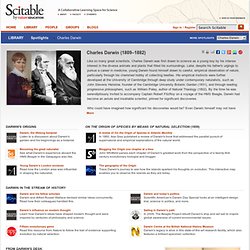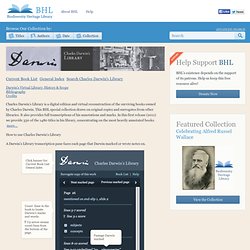

Evo_large.gif (GIF Image, 2420x915 pixels) - Scaled (45%) Evolution of Evolution - 150 Years of Darwin's "On the. Evolution - Charles Darwin's 200th Birthday. Darwin's personal library and annotations online. Evolution – timeline. Charles Darwin Spotlight. Like so many great scientists, Charles Darwin was first drawn to science as a young boy by his intense interest in the diverse animals and plants that filled his surroundings.

Later, despite his father's urgings to pursue a career in medicine, young Darwin found himself drawn to careful, empirical observation of nature, particularly through his cherished hobby of collecting beetles. His empirical instincts were further developed at the University of Cambridge through deep study under contemporary naturalists, such as John Stevens Henslow, founder of the Cambridge University Botanic Garden (1831), and through reading progressive philosophers, such as William Paley, author of Natural Theology (1802). By the time he was serendipitously invited to accompany Captain Robert FitzRoy on a voyage of the HMS Beagle, Darwin had become an astute and insatiable scientist, primed for significant discoveries.
Who could have imagined how significant his discoveries would be? The Complete Work of Charles Darwin Online. Biodiversity Heritage Library. Current Book List General Index Search Charles Darwin's Library Charles Darwin’s Library is a digital edition and virtual reconstruction of the surviving books owned by Charles Darwin.

This BHL special collection draws on original copies and surrogates from other libraries. It also provides full transcriptions of his annotations and marks. In this first release (2011) we provide 330 of the 1480 titles in his library, concentrating on the most heavily annotated books. more... How to use Charles Darwin's Library A Darwin’s Library transcription pane faces each page that Darwin marked or wrote notes on. Entries in the pane have line numbers, such as lines 5-7. In books scanned from Darwin’s personal copies you will see his writing. Click the banner to reach the Current Book List and the General Index. The pane uses a very few specialized terms and symbols: The transcription pane uses special characters to represent some elements of Darwin's annotations.
Support United Kingdom United States. The Beagle Project Blog: Pics in space. One of the most exciting science projects we plan to do aboard the new Beagle is to correlate ocean surface biological surveys with images of our position taken at the same time by our astronaut friends aboard the International Space Station.

The premise of such a study got a big boost this week when Nature published special News Features and Commentaries on earth monitoring. The issue includes an essay by Stewart Brand of the Long Now Foundation. Way back in 1966 Brand promoted 'the idea of photographing the "whole Earth" from space, hoping that it would stimulate humanity's interest in its mega-habitat.' And oh, how it did. Two years later, in December 1968, Apollo 8 astronauts Frank Borman, Jim Lovell and William Anders became the first humans to leave Earth orbit and travel far enough away to see and photograph our fragile planet in the round.
On Christmas Eve, they transmitted the first images of the whole Earth that anyone had ever seen. Candle light. Origins. By Lucas Laursen Charles Darwin may have had his biggest impact on biology, but he began his scientific career as a geologist.

So it’s appropriate that earlier this year, retired geologist John Ramsay, who had long studied the famed biologist’s life, accepted a commission to compose a Darwin-themed string quartet. Darwin “did some pretty fundamental geological mapping," says Ramsay, drawing a parallel to his own geological career, during which he has drawn maps of the Scottish Highlands, South Africa, and the Swiss Alps.
Ramsay says he and Darwin also share a penchant for putting "ideas that spring from other parts of one's life" into their current work. He notes that Darwin applied lessons from Earth's landscape to biology, adapting, for example, Charles Lyell's theory of gradual geological change to living things. At the beginning of the piece, a disorganized Earth takes shape, with the core, mantle, and crust emerging into distinct musical themes.